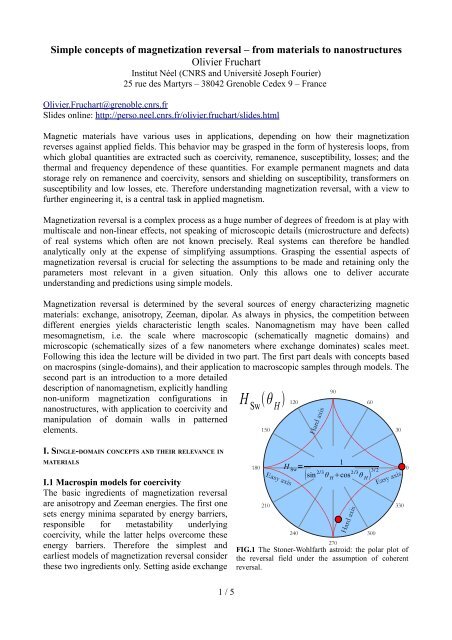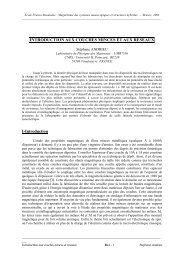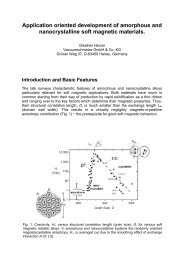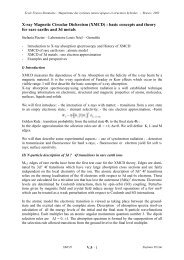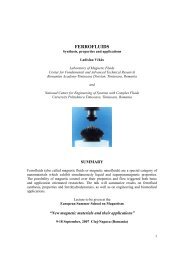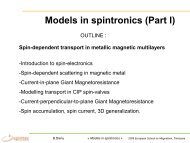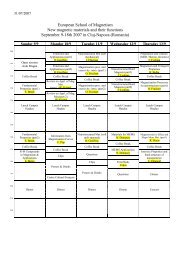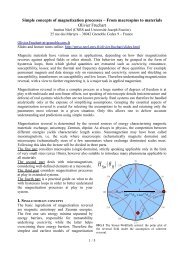Magnetization reversal - Abstract
Magnetization reversal - Abstract
Magnetization reversal - Abstract
Create successful ePaper yourself
Turn your PDF publications into a flip-book with our unique Google optimized e-Paper software.
Simple concepts of magnetization <strong>reversal</strong> – from materials to nanostructures<br />
Olivier Fruchart<br />
Institut Néel (CNRS and Université Joseph Fourier)<br />
25 rue des Martyrs – 38042 Grenoble Cedex 9 – France<br />
Olivier.Fruchart@grenoble.cnrs.fr<br />
Slides online: http://perso.neel.cnrs.fr/olivier.fruchart/slides.html<br />
Magnetic materials have various uses in applications, depending on how their magnetization<br />
reverses against applied fields. This behavior may be grasped in the form of hysteresis loops, from<br />
which global quantities are extracted such as coercivity, remanence, susceptibility, losses; and the<br />
thermal and frequency dependence of these quantities. For example permanent magnets and data<br />
storage rely on remanence and coercivity, sensors and shielding on susceptibility, transformers on<br />
susceptibility and low losses, etc. Therefore understanding magnetization <strong>reversal</strong>, with a view to<br />
further engineering it, is a central task in applied magnetism.<br />
<strong>Magnetization</strong> <strong>reversal</strong> is a complex process as a huge number of degrees of freedom is at play with<br />
multiscale and non-linear effects, not speaking of microscopic details (microstructure and defects)<br />
of real systems which often are not known precisely. Real systems can therefore be handled<br />
analytically only at the expense of simplifying assumptions. Grasping the essential aspects of<br />
magnetization <strong>reversal</strong> is crucial for selecting the assumptions to be made and retaining only the<br />
parameters most relevant in a given situation. Only this allows one to deliver accurate<br />
understanding and predictions using simple models.<br />
<strong>Magnetization</strong> <strong>reversal</strong> is determined by the several sources of energy characterizing magnetic<br />
materials: exchange, anisotropy, Zeeman, dipolar. As always in physics, the competition between<br />
different energies yields characteristic length scales. Nanomagnetism may have been called<br />
mesomagnetism, i.e. the scale where macroscopic (schematically magnetic domains) and<br />
microscopic (schematically sizes of a few nanometers where exchange dominates) scales meet.<br />
Following this idea the lecture will be divided in two part. The first part deals with concepts based<br />
on macrospins (single-domains), and their application to macroscopic samples through models. The<br />
second part is an introduction to a more detailed<br />
description of nanomagnetism, explicitly handling<br />
90<br />
non-uniform magnetization configurations in H<br />
nanostructures, with application to coercivity and Sw<br />
θ H<br />
120<br />
60<br />
manipulation of domain walls in patterned<br />
elements.<br />
150<br />
30<br />
Hard axis<br />
I. SINGLE-DOMAIN CONCEPTS AND THEIR RELEVANCE IN<br />
MATERIALS<br />
I.1 Macrospin models for coercivity<br />
The basic ingredients of magnetization <strong>reversal</strong><br />
are anisotropy and Zeeman energies. The first one<br />
sets energy minima separated by energy barriers,<br />
responsible for metastability underlying<br />
coercivity, while the latter helps overcome these<br />
energy barriers. Therefore the simplest and<br />
earliest models of magnetization <strong>reversal</strong> consider<br />
these two ingredients only. Setting aside exchange<br />
180<br />
Easy axis<br />
210<br />
1<br />
H Sw<br />
=<br />
sin 2/3 θ H<br />
cos 2 /3 θ H 3/2<br />
240<br />
FIG.1 The Stoner-Wohlfarth astroid: the polar plot of<br />
the <strong>reversal</strong> field under the assumption of coherent<br />
<strong>reversal</strong>.<br />
270<br />
Hard axis<br />
300<br />
Easy axis<br />
330<br />
0<br />
1 / 5
energy implies that magnetization is assumed to be uniform in the systems considered. This yields<br />
so-called coherent rotation models, as first outlined by Stoner and Wohlfarth [STO48], and the<br />
famous astroid first drawn and geometrical constructions discussed to infer various informations by<br />
Slonczewski [SLO56]. In a simple case we will derive energy barriers preventing magnetization<br />
<strong>reversal</strong>, and infer the dependence of coercivity on temperature and time scales, and introduce the<br />
effect of superparamagnetism. Relevance for real small magnetic elements will be discussed based<br />
on examples.<br />
I.2 Coercivity in materials<br />
In real extended systems the assumption of<br />
uniform magnetization is obviously not valid, and<br />
coherent rotation models usually fail. In particular<br />
the experimental value of coercivity is often much<br />
smaller than the one expected from the value of<br />
anisotropy. This discrepancy has long been known<br />
as Brown paradox. This 'paradox' is lifted by the<br />
fact that in reality magnetization <strong>reversal</strong> instead<br />
proceeds via nucleation of small reversed<br />
domains, and possibly the propagation of the<br />
associated domain walls [GIV2003]. This stresses<br />
that the engineering of microstructure is of<br />
particular importance to hinder or ease these<br />
processes to yield application-oriented materials,<br />
such as highly-coercive materials (permanent<br />
magnets). Simple models to account for these<br />
processes will be presented, including the<br />
Fatuzzo-Labrune [FAT1962,LAB1989] model<br />
relevant for thin films.<br />
I.3 Novel ways for magnetization <strong>reversal</strong><br />
In the past decade, along with knowledge and<br />
FIG.2. Nucleation (lower-left) versus propagation<br />
(upper-right) extreme schemes for magnetization<br />
<strong>reversal</strong>, taken from the historical paper of [LAB1989].<br />
technological progresses accompanying the field of spintronics, new ways of reversing<br />
magnetization have emerged. These open new fundamental fields, as well as potential applications.<br />
We will shortly discuss thermally-assisted <strong>reversal</strong> (decrease the coercivity with heating),<br />
precessional dynamics and switching [BAC1999] (typical time scale 1ns), spin transfer<br />
torque [SLO1996,BER1996] (<strong>reversal</strong> using spin-polarized currents as a mean to bring the<br />
momentum required to reverse magnetization), electric fields [WEI2007] (direct through charge<br />
transfer, or through induced stress), all-optics [STA2007] (so-called inverse Faraday and Kerr<br />
effects).<br />
FIG.3. All-optical magntization <strong>reversal</strong> using the inverse Faraday effect [STA2007].<br />
2 / 5
II. NON-SINGLE-DOMAIN EFFECTS<br />
II.1 Dipolar energy<br />
Dipolar energy is often the core of problems and wealth of behaviors in nanomagnetism, owing to<br />
its non-local character. It is therefore important to review the different ways it can be handled, and<br />
its basic consequences on magnetization <strong>reversal</strong>. We will introduce the concepts of volume and<br />
surface charges, dipolar field and potential, demagnetizing coefficients [BEL2003] (calculation,<br />
hypothesis, examples, relevance and use). Textbook consequences on hysteresis loops will be given:<br />
hard axis loops, correction of internal fields etc. finally, ways to infer collective effects (often<br />
dipolar-related) from more elaborate loops will be described, such as irreversible versus reversible<br />
contributions to hysteresis loops, Henkel plots, Preisach models.<br />
II.2 Nanomagnetism – Coercivity in patterned elements<br />
Flat thin film magnetic elements patterned by e.g. lithography are model systems for<br />
nanomagnetism, owing to their relative simplicity (two-dimensional magnetization configurations),<br />
and our ability to essentially characterize them fully using plane view magnetic microscopies. There<br />
are also obviously objects of prime importance for technology. As a consequence their study is<br />
extremely well documented, and we will base our description of nanomagnetism on such elements.<br />
Characteristic length scales of nanomagnetism will be introduced: Bloch wall width, exchange<br />
length, quality factor. Well below these length scales systems are mostly uniformly-magnetized.<br />
Upon increasing this size deviations from strictly-speaking single-domain appear (e.g. flower and<br />
leaf states associated with configurational anisotropy [SCH1988,COW1998]). Above these sizes<br />
flat elements may retain an essentially single-domain magnetization configuration owing to the<br />
shorter range of dipolar field in two dimensions. Then end domains may occur leading to so-called<br />
C and S states; engineering of the coercivity with end geometries (e. g. flat or pointed) will be<br />
outlined. Non-single-domain states will finally be described, with the vortex state, and more<br />
generally the Van den Berg construction [VAN1984], and Bryant and Suhl model for flux-closure<br />
domains.<br />
Various reviews are available on nanomagnetism: [HUB1999], [MAR2003], [SLO2003],<br />
[FRU2005]...<br />
FIG.4. Flux-closure (so-called Landau state, left) and essentially single-domain state with<br />
end domains (right) [KIR1997].<br />
II.3 Manipulation of magnetic domain walls<br />
We will start with a reminder about domain walls in thin films (Bloch versus Néel [NEE1955],<br />
energetics of domains versus their angle, and its consequences such as cross-tie walls, perpendicular<br />
media). Nowadays a very active field of research is concerned with the study and propagation of<br />
domain walls in nanostripes (typically 100nm wide). In this framework we will describe usual<br />
3 / 5
concept of reservoirs and nucleation for injecting domain walls in stripes, pinning domain walls.<br />
Beyond their mere location, inner details of the domain walls will be discussed, such as head-tohead<br />
domain walls (vortex versus transverse), and magnetization processes inside domain<br />
walls (FRU2009] and magnetic vortices [SHI2000,WAE2007].<br />
REFERENCES<br />
[BAC1999] C. H. Back, R. Allenspach, W. Weber, S. S. P. Parkin, D. Weller, E. L. Garwin & H.<br />
C. Siegmann, Minimum Field Strength in Precessional <strong>Magnetization</strong> Reversal,<br />
Science 285, 864-867 (1999)<br />
[BEL2003] M. Beleggia & M. D. Graef, On the computation of the demagnetization tensor field<br />
for an arbitrary particle shape using a Fourier space approach, J. Magn. Magn. Mater.<br />
263, L1-9 (2003)<br />
[BER1996] L. Berger, Emission of spin waves by a magnetic multilayer traversed by a current,<br />
Phys. Rev. B 54, 9353 (1996)<br />
[COW1998] R. P. Cowburn & M. E. Welland, Phase transitions in planar magnetic nanostructures,<br />
[FAT1962]<br />
Appl. Phys. Lett. 72, 2041-2043 (1998)<br />
E. Fatuzzo, Theoretical considerations on the switching transient in ferroelectrics,<br />
Phys. Rev. 127, 1999-2005 (1962)<br />
[FRU2005] O. Fruchart & A. Thiaville, Magnetism in reduced dimensions, C. R. Physique 6, 921<br />
(2005) [Topical issue, Spintronics].<br />
[FRU2009] F. Cheynis, A. Masseboeuf, O. Fruchart, N. Rougemaille, J. C. Toussaint, R.<br />
Belkhou, P. Bayle-Guillemaud & A. Marty, Controlled Switching of Néel Caps in<br />
Flux-Closure Magnetic Dots, Phys. Rev. Lett. 102, 107201 (2009)<br />
[GIV2003] D. Givord, M. Rossignol & V. M. T. S. Barthem, The physics of coercivity, J. Magn.<br />
Magn. Mater. 258-259, 1-5 (2003)<br />
[HUB1999] A. Hubert & R. Schäfer, Magnetic domains, Springer (1999).<br />
[KIR1997]<br />
[LAB1989]<br />
FIG.5. Illustration of the nucleation of head-to-head domain walls in zig-zag stripe<br />
patterns [TAN2000].<br />
K. J. Kirk, J. N. Chapman & C. D. W. Wilkinson, Switching fields and magnetostatic<br />
interactions of thin film magnetic nanoelements, Appl. Phys. Lett. 71, 539-541<br />
(1997)<br />
M. Labrune, S. Andrieu, F. Rio & P. Bernstein, Time dependence of the<br />
magnetization process of RE-TM alloys, J. Magn. Magn. Mater. 80, 211-218 (1989)<br />
[MAR2003] J.I. Martin et coll., Ordered magnetic nanostructures: fabrication and properties, J.<br />
Magn. Magn. Mater. 256, 449-501 (2003).<br />
[NEE1955] L. Néel, Énergie des parois de Bloch dans les couches minces, C. R. Acad. Sci. 241,<br />
533-536 (1955)<br />
[SCH1988] M. A. Schabes & H. N. Bertram, <strong>Magnetization</strong> processes in ferromagnetic cubes, J.<br />
4 / 5
Appl. Phys. 64, 1347-1357 (1988)<br />
[SHI2000] T. Shinjo, T. Okuno, R. Hassdorf, K. Shigeto & T. Ono, Magnetic vortex core<br />
observation in circular dots of permalloy, Science 289, 930 (2000)<br />
[SKO2003] R. Skomski, Nanomagnetics, J. Phys.: Cond. Mat. 15, R841–896 (2003).<br />
[SLO1956] J. C. Slonczewski, Theory of magnetic hysteresis in films and its applications to<br />
computers, Research Memo RM 003.111.224, IBM Research Center, Poughkeepsie,<br />
NY (1956)<br />
[SLO1996] J. C. Slonczewski, Current-driven excitation of magnetic multilayers, J. Magn.<br />
Magn. Mater. 159, L1-L7 (1996)<br />
[STA2007] C. D. Stanciu, F. Hansteen, A. Kimel, A. Kirilyuk, A. Tsukamoto, A. Itoh & T.<br />
Rasing, All-Optical Magnetic Recording with Circularly Polarized Light, Phys. Rev.<br />
Lett. 99, 047601 (2007)<br />
[STO1948] E. C. Stoner & E. P. Wohlfarth, A Mechanism of Magnetic Hysteresis in<br />
Heterogeneous Alloys, Phil. Trans. Roy. Soc. Lond. A 240, 599-642 (1948).<br />
Reprinted: E. C. Stoner & E. P. Wohlfarth, reprint of 1948 'A Mechanism of<br />
Magnetic Hysteresis in Heterogeneous Alloys', IEEE Trans. Magn. 27, 3469-3518<br />
(1991).<br />
[TAN2000] T. Taniyama, I. Nakatani, T. Yakabe & Y. Yamazaki, Control of domain structures<br />
and magnetotransport properties in patterned ferromagnetic wires, Appl. Phys. Lett.<br />
[VAN1984]<br />
76, 613 (2000)<br />
H. A. M. Van den Berg, A micromagnetic approach to the constitutive equation of<br />
soft-ferromagnetic media, J. Magn. Magn. Mater 44, 207-215 (1984)<br />
[WAE2007] B. V. Waeyenberge, A. Puzic, H. Stoll, K. W. Chou, T. Tyliszczak, R. Hertel, M.<br />
Fähnle, H. Brückl, K. Rott, G. Reiss, I. Neudecker, D. Weiss, C. H. Back & G.<br />
Schütz, Magnetic vortex core <strong>reversal</strong> by excitation with short bursts of an<br />
alternating field, Nature 444, 461-464 (2006)<br />
[WEI2007]<br />
M. Weisheit, S. Fähler, A. Marty, Y. Souche, C. Poinsignon & D. Givord, Electric<br />
Field–Induced Modification of Magnetism in Thin-Film Ferromagnets, Science 315,<br />
349 (2007)<br />
5 / 5


